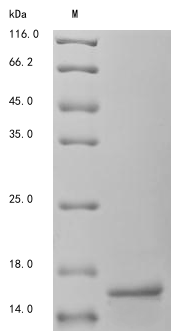Recombinant Mouse Transthyretin (Ttr) is produced through a yeast expression system and covers amino acids 23 to 147. This partial-length protein comes with an N-terminal 6xHis-tag, which makes purification more straightforward. The product shows purity levels above 90%, as determined by SDS-PAGE analysis. It's designed strictly for research purposes and shouldn't be used in clinical or diagnostic settings.
Transthyretin functions as a transport protein, mainly carrying thyroid hormones and retinol-binding protein-bound retinol through the bloodstream. The protein appears to play an important role in keeping thyroid hormones and vitamin A levels balanced. Given its involvement in these vital processes, transthyretin has become a key focus in biomedical research—especially when scientists want to understand how it's structured and what it does.
Potential Applications
Note: The applications listed below are based on what we know about this protein's biological functions, published research, and experience from experts in the field. However, we haven't fully tested all of these applications ourselves yet. We'd recommend running some preliminary tests first to make sure they work for your specific research goals.
Mouse Ttr is a tetrameric protein that requires precise folding, proper tetramerization, and specific tertiary structure for its functional activity in thyroxine transport. The yeast expression system provides a eukaryotic folding environment that supports disulfide bond formation and proper oligomerization. The N-terminal 6xHis-tag is relatively small and may cause minimal steric interference. The partial fragment (23-147aa) represents the mature protein without the signal peptide and should contain the complete monomeric unit. However, the probability of correct folding with functional tetramerization activity requires experimental validation.
1. In Vitro Protein-Protein Interaction Studies
This application carries a moderate risk. TTR interactions with binding partners (e.g., RBP) require proper tetramerization. If correctly folded and tetrameric (verified), the protein may identify physiological interactions; if misfolded/unverified, there is a risk of non-specific binding. The His-tag generally doesn't interfere with most interaction interfaces.
2. Antibody Development and Validation
This application is highly suitable. Antibody development relies on antigenic sequence recognition. The yeast-expressed protein provides proper folding and potential post-translational modifications, making it an excellent immunogen for generating TTR-specific antibodies.
3. Structural and Biophysical Characterization
These studies are essential for determining folding status. Techniques should include size-exclusion chromatography (to assess tetramer formation), circular dichroism spectroscopy, and thermal stability assays. The yeast expression system likely supports proper folding for meaningful structural analysis.
4. Comparative Species Analysis
Meaningful comparative studies require a native tetrameric structure. If correctly folded and tetrameric (verified), the protein enables valid evolutionary comparisons; if misfolded/unverified, comparative analyses would be misleading.
Final Recommendation & Action Plan
The yeast-expressed TTR with a small His-tag has a high probability of correct folding and tetramerization due to the eukaryotic expression system. Begin with Application 3 (Structural Characterization) to validate tetramer formation through size-exclusion chromatography and analytical ultracentrifugation. Applications 1 and 4 require this validation before proceeding. Application 2 (antibody development) can proceed immediately. The yeast expression system is particularly suitable for this secretory protein that naturally undergoes tetramerization.






